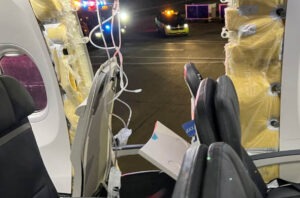Fight or Flight: Boeing’s Scramble To Salvage Its Reputation
Published on February 27, 2024, 10:53 a.m.
by Jackson Olmstead.
After boarding a flight and the plane departs the gate, the attendants give passengers a safety briefing. The usual requests and advisories include keeping your tray table folded, your seat in the upright position, and what to do with your seat cushion in case of a water landing. What the safety briefings lack is what to do if the side of the plane suddenly opens to the outside sky.

That’s exactly what happened on an Alaska Airlines flight bound for California from Portland, Oregon, in early January 2024. Flight 1282’s aircraft, a Boeing 737 MAX-9, suffered an extremely rare but serious failure of a door plug on the Jan. 5 flight, causing the side of the plane to explosively open at 16,000 feet. What is not rare, though, is quality control issues for Boeing in recent years.
Is Boeing a bust?
Taking previous issues in to consideration when deciding the right path for a crisis response is preeminent. Unfortunately for Boeing as a whole and the 737 model specifically, there are quite a few things to note.
One major problem with Boeing’s 737 MAX model aircraft is that mistakes on these planes have killed people before. Just a few short years ago two separate plane crashes — with Lion Air in 2018 and Ethiopian Airlines in 2019 — killed a combined 346 passengers and crew. Both of these incidents involved Boeing’s 737 MAX-8 aircraft, which was unveiled just two years before the first incident.
These incidents caused 737 MAX-8 aircraft to be grounded temporarily in the United States and many other countries in 2019 and stayed that course for two years. Following these major crashes, Boeing’s stock prices were cut in half and never recovered, continuing to fall amid this newest issue for the manufacturer.
Thankfully in the Alaska Airlines situation, no one was seriously injured.

Past issues ground new orders
Even from a theoretical perspective, Boeing has serious history with crises that have to be evaluated when determining how much responsibility the company has in the situation. However, just because Boeing may believe it isn’t heavily responsible does not mean its customer airlines will see it that way.
In fact, United Airlines CEO Scott Kirby said its company is not counting on its orders to be filled for nearly 300 Boeing 737 MAX-10 aircraft. Kirby also expressed disappointment in Boeing’s continued manufacturing issues, saying that this latest incident was “the straw that broke the camel’s back.” United currently has 79 of the MAX-9 aircraft that had to be grounded for inspection as a result of the Alaska Airlines incident.
The important thing to note is that Boeing’s reputation is paramount, because for its planes to sell to airlines, the customers of the airlines have to believe the planes they are ascending 30,000 feet into the sky in are safe. If the customers of the airlines don’t believe the planes are safe, the airlines won’t buy the planes. This is going to be one of Boeing’s largest issues in the coming months as airlines evaluate whether fulfilling their orders of MAX-10 aircraft are in their best interest.
Boeing’s response takes flight
So what did Boeing do right or wrong in its response? It’s hard to say right now.

One thing that is clear is that Boeing was prompt in its response to the public and Alaska Airlines, quickly identifying the issue. Boeing CEO Dave Calhoun delivered an address to company employees and stated that Boeing will “approach [an FAA investigation] with 100% complete transparency.”
When looking at this investigation through the lens of situational crisis communication theory, the two main factors in determining both the organization’s responsibility and future reputation lie in reflecting on the past. Prior reputation evaluations and crisis history allow a public relations practitioner to learn from mistakes or make improvements upon previous responses to crises. The practitioner heading this response likely made a wise choice in deciding to use a strategy that allowed Boeing to accept responsibility in the wake of its previous issues. Boeing also has a page on its website dedicated to news, actions, and updates about the crisis and how the company is responding.
While Boeing’s future still looks tumultuous for the weeks and months ahead, what is clear is that the company appears to have responded adequately to the crisis. Air travelers will likely need a lengthy amount of time to begin to trust a manufacturer that has their lives in its hands when they fly.
Will time be the only measure of success in this situation, or is Boeing already seeing the light at the end of the tunnel?




